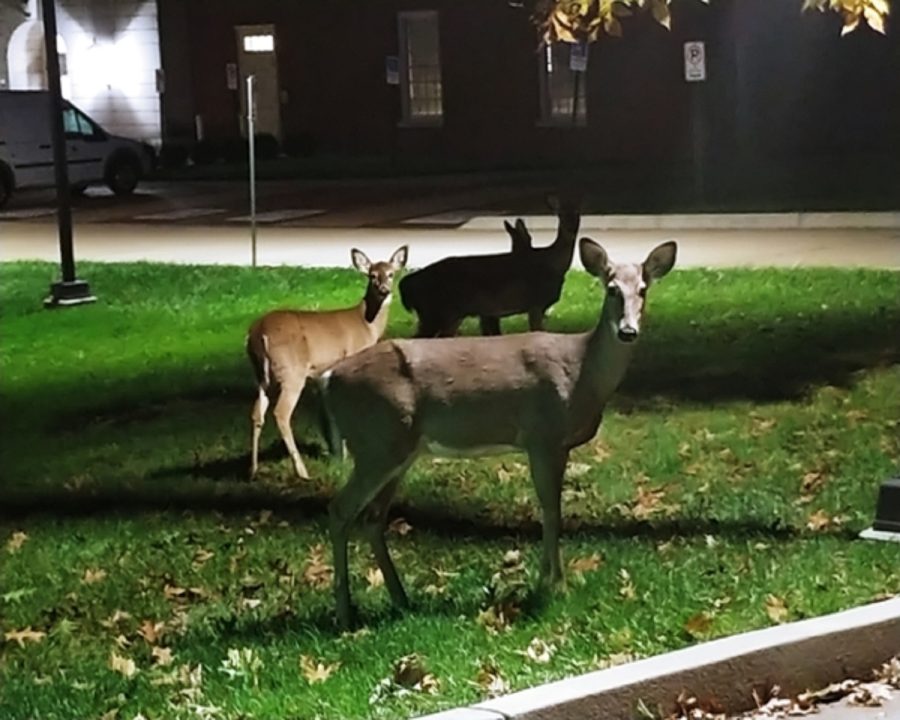Miami to allow bow hunting of deer in natural areas – Oxford Observer
Photo by Steve Sullivan
Deer overpopulation is becoming a problem in Oxford’s ecosystem. Deer such as these are a frequent sight on the Miami campus.
The Miami University Natural Areas Committee has proposed controlled bow hunts in tree stands to manage deer overpopulation on the university’s 1,000 acres of woodland property.
The proposal would allow hunting from Nov. 15 until deer season closes on Feb. 5. Trails would remain open during the hunts. The proposal was unveiled at a public Zoom meeting on May 5.
Research in the natural areas by faculty and students since 2010 shows a decreased count in tree seedlings, saplings and wildflowers, as well as less species diversity, according to David Gorchov, committee chair and biology professor. The committee identified deer as the primary source of damage.
“The reason the seedlings and saplings are so important is those are the future canopy trees,” Gorchov said.
Hunters will be required to complete the Ohio Hunter Education course, follow state archery requirements, and receive a letter of approval from the Natural Areas manager. Butler County’s bag limit is three deer, including at maximum one antlered.
Tree stands will be permitted in the least-used areas of the preserves, including south of the Collins Run Creek in the Western Woods, the eastern part of the Bachelor Preserve, the Reinhart Preserve, and the gated land around the WRA Cabin, as well as the land around the Ecology Research Center.

“We don’t want there to be any risks to anyone using the trails,” Gorchov said. “If a hunter misses, [the arrow] goes straight into the ground, so there is zero risk to people, dogs, and other animals.”
Signs will be posted at trailheads to notify guests of the hunting season. Current rules for guests to stay on the trails will remain in effect, but no further safety precautions will be needed, according to Gorchov.
“There’s no reason to wear bright orange clothing or anything,” Gorchov said. “The hunters will not be near the trails.”
Hunters are encouraged to pursue does (female deer) rather than bucks (male deer with antlers). This is because the number of fawn births depends more on the amount of reproducing does than bucks, and the behavior of the females differ from the roaming males, according to Gorchov.
“The does are more territorial,” Gorchov said. “We are focused on reducing localized deer damage.”
Gorchov said the group has deliberated deer population management ideas for over a year.
Author Thomas E. Peterson’s master’s thesis from 2018 estimated that, in Miami Natural Areas and Hueston Woods, there were 24 deer per square mile in the spring and 16 deer per square mile in the summer. He found the most deer in Miami’s Bachelor Preserve and Western Woods, with 46 and 35 deer per square mile in the spring, respectively.
The Natural Areas deer management website references a 2003 study that states that more than 21 deer per square mile can cause environmental deterioration.
The committee’s concern for tree regeneration heightened with the loss of ash trees as the invasive emerald ash borers spread from southeastern Michigan to western Ohio in the 2010s.
The Natural Areas Committee will later make efforts to control invasive shrub species, including honeysuckle. Though tree seedlings grow better away from honeysuckle, these shrubs are currently protecting the native plants from deer browsing, according to Gorchov.
Deer activity and population will be monitored with trail cameras, fecal pellet counts, and seedling growth.
The proposed plan will be reviewed by university administration. Comments about the plan may be sent to [email protected].



